Roger Deakins cinematography includes Fargo, Skyfall, Sicario, No Country for Old Men, and finally he won an Academy Award for Cinematography for Blade Runner 2049 and again in 2020 for 1917. While the Academy finally recognized Deakins work, most of us have been in awe of him long before that. We watched Roger Deakins movies, interviews, and used his blog to compile the best Roger Deakins cinematography tips & techniques.
Watch: How Roger Deakins Learned to Light
Roger deakins basics
Essential Roger Deakins
The more you research Roger Deakins, the more you will find some of his very useful and specific lessons on cinematography. You don't get a better film school than watching how Deakins shot 1917.
How Deakins Shot 1917 • Subscribe on YouTube
Some of are technical. Others are philosophical. All are valuable. Here's Part 2 of our Cinematography Techniques series with Deakins discussing mixing light, finding the right light for the job, and the subtle but essential art of lighting the human face.
Deakins Cinematography Techniques Pt. 2 • Subscribe on YouTube
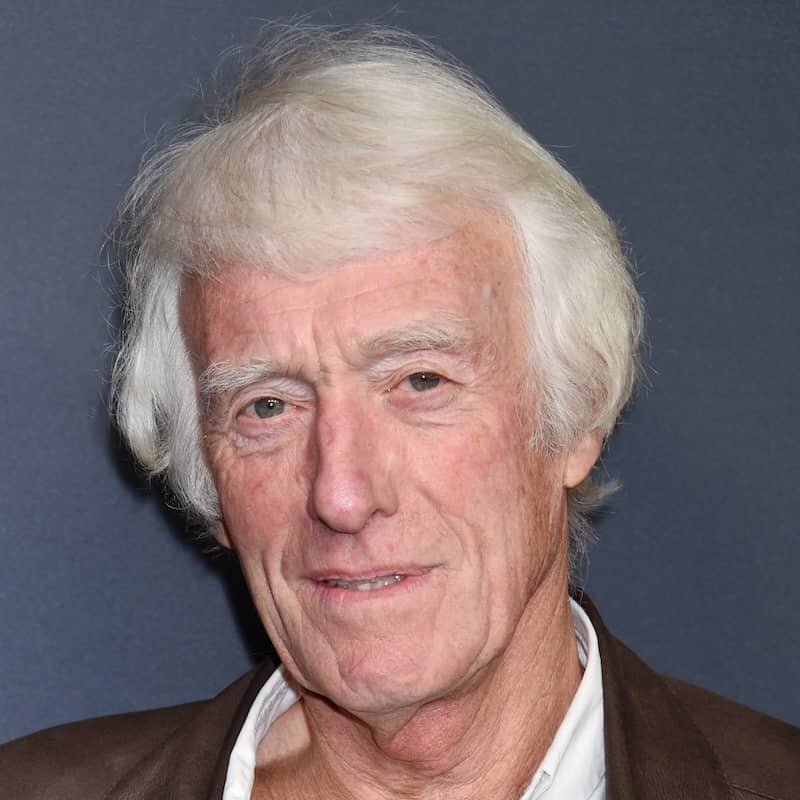
Roger Deakins
I learned a lens operated to its best advantage at an aperture of T4-5.6. ...that a true cinematographer used Brute Arcs to light a set and a geared head (operated by a specialist) to achieve smooth camera-panning shots. But I also learned Raoul Coutard operated the camera himself, and that he would often shoot with a handheld Camiflex camera and sometimes light his shots using household bulbs and tinfoil reflectors.To truly understand what Roger Deakins values in his images and cinematography, you must look at the common thread between the directors with which he works, and the films they've created together.
We’ve scoured articles, videos, interviews, and at one point just sat outside his house for a few nights to see what we could learn from this master cinematographer.
What did we learn?
He has a great security system, really fast guard dogs, some pretty nectar home lighting, and the following cinematography tips and techniques.
Roger Deakins Cinematography Techniques
Roger Deakins cinematography tips
Below is a list of specific filmmaking tips held dear by Roger Deakins himself. He is consistent across interviews, his blog, and any other resource we could find. Here's a video we put together to kick off our Roger Deakins cinematography style and tips.
Roger Deakins Cinematography Tips • Subscribe on YouTube
SUPPORT THE VISUAL SOUL OF THE PROJECT
Roger Deakins tries to identify the unique visual soul for each project he works on, and for him this often reveals cinematic opportunities. Each story is inherently different, so identify the special qualities of your story to help coordinate your visuals with the theme of the project.
Roger Deakins on visual authenticity
A film like A Serious Man should have different visuals than Skyfall.
No Country for Old Men and True Grit are good movies to compare.
Both have the same director.
Both are set in the American West.
Both are dramas.
But they each need to have their own unique cinematography.
Now, that doesn’t mean Deakins abandons the lessons he learns from film to film, and conversely, he won’t change his approach just to make it different from his former projects.
Just keep in mind that your personal style is ancillary to the style of the project. Want to capture images like Roger Deakins?
Support the visual soul of your project.
Free downloadable bonus
FREE Download
Ultimate Guide to Exposure
The Exposure Triangle is something every photographer and cinematographer needs to master. Download our FREE e-book to get in-depth explanations and tutorials on topics like aperture, ISO, shutter speed, and how to balance these settings to nail perfect exposure every time.
WORK WITH DIRECTORS YOU RESPECT
The idea that Roger Deakins gets to work with The Coen Bros and Sam Mendes purely based on the quality of his cinematography is silly.
Roger Deakins gets those jobs because over the years he built relationships with directors, collaborated well, and built successful relationships that lead to more films.
These directors have similar sensibilities to Deakins, and he helps by being a pleasure to work with. He carefully vets directors by…. wait for it… talking with them about creative ideas and finding common ground.
Deakins anecdote on collaborating with Coen Brothers
If you’re a cinematographer trying to build a reel or hustling to pay bills you may think that footage is king, and no matter what the director wants or says you are going to do whatever you need to get great images that help build your reel.
Problem is, you’re most likely destroying relationships that may have paid off in the future, and getting cool looking footage in a mediocre film doesn’t prove anything beyond some of your lighting skills.
Sam Mendes and Denis Villeneuve didn’t reach out to Deakins because they saw a cool shot they liked in some bad film he shot.
Binocular POV in Blade Runner 2049
They were blown away by the stories he told and saw narrative value. Great directors and cinematographers need one another, and there is a reason the best work with the same people over, and over, and over.
The Coen Brothers storyboard everything even before Deakins comes on board, whereas Villeneuve and Deakins storyboard together.



Roger Deakins
I learned John Alton, ASC was ostracized in his time for his radical approach to lighting, eschewing the use of greenbeds and declaring, “It’s not what you light, it’s what you don’t light” that’s important. I learned Conrad Hall, ASC overexposed his negative by some 2 1/2 stops to achieve the stunning anamorphic images in Abraham Polonsky’s Tell Them Willie Boy Is Here (1969) — a technique he repeated for the exteriors in John Huston’s 1:85:1 feature Fat City (1972).The fact that he has this calm versatility gets him jobs, and he helps deliver great visuals with directors with whom he is on the same page.
Don’t be a diva. Don’t be a pain. Don’t make everything about your images, or you will destroy your personal relationships with directors.
If your relationship with the director doesn’t matter to you, you’re not getting much closer to capturing images like Roger Deakins.
DO NOT FEAR DIGITAL VIDEO
Roger Deakins has shot plenty of movies on film, and plenty through the use of digital cameras. He doesn’t make a big deal over having one or the other, and he can bounce back and forth with ease.
Roger Deakins on digital vs film
Both have their advantages, and Deakins recognizes this. Some filmmakers are very specific about their preference, but Deakins is focused elsewhere.
The way he lights scenes, the camera placement, the number of cameras, the lenses, and directors he works with all matter more to him than film vs digital.
TAKE ADVANTAGE OF THE FILM MEDIUM
Deakins works with directors who take advantage of the medium. This may be the most important advice you’ll ever hear.
Many films don’t do this, and that’s why they don’t deliver.
Cinema is different from television because of the economics, but in the last ten years, that gap has slowly been closing.
Curiously enough, some movie makers have lost sight of why television is catching up. They instead have elected to absorb the principles of early television which prioritizes writing and efficiency rather than aesthetics.
Deakins does not, and neither do the directors that he works with.
They use visuals, camera movement, sounds design, and film grammar all to their advantage whenever possible.
RELATED POSTS
Roger deakins cinematography techniques
Roger's filmmaking techniques
Below is a list of specific cinematography techniques used and held dear by Roger Deakins himself. Each of these guidelines will help you make cinematography decisions that mimic the style of Roger Deakins.
USE PRIME LENSES AS MUCH AS POSSIBLE
In most of the modern films Roger Deakins shoots, he uses Zeiss prime lenses with an Arri Alexa. These are expensive pieces of equipment, but there is still something to be said about the choices he makes.
He used both Zeiss Master Primes, and Cooke S4 primes on No Country for Old Men, but since that film, he has shied away from using Cookes.
Roger Deakins on the Master Prime Lenses
Primes lenses align with his penchant for a single camera because they force the filmmaker to move the camera to the "correct" angle for their lens choice rather than simply zooming in to get shot variation from the same place.
He also prefers how compact the prime lenses are because a zoom lens will often have a longer build to support the variable focal length.
USE A WIDE LENS TO CONNECT YOUR VIEWER
Deakins like to shoot singles, and often he likes to shoot them on a wide lens that is placed near the actor during a scene.
What do you gain from this?
Keeping a wide angle lens close to the actor can generate intimacy.
Cinematography style of Roger Deakins
If you use a wide lens and keep a large or deep depth of field, you can show surrounding set design and the location of the scene to help create a world. Here's a quick breakdown of how aperture works to create depth of field and its various storytelling advantages.
What is Aperture? • Subscribe on YouTube
That way, with each line of dialogue, we are reminded who the characters and how they fit in with the world around them.
An OTS is a great way to connect characters within a scene, but it may not connect viewers to the character or to connect characters with each other. Check out the shot list to see how to plan shots like Deakins:
StudioBinder Shot List Feature
Deakins uses these visual elements to connect the viewer to the character. This is his personal style, and every decision he makes is informed by his central philosophy. That consistent attention to his overall goal is why he has captured some of the greatest moments in the history of cinema.
CAPTURE STABLE FOOTAGE AS MUCH AS POSSIBLE
Deakins prefers stable footage. Stable footage that you let linger a bit is often more intimate because you have more time to digest the images.
Again, Deakins could work with anyone he wants, so the fact that he collaborates with Coen Brothers, Sam Mendes, and Denis Villeneuve on a regular basis should inform you about his own personal style.
Deakins is a thoughtful person, and he wants the viewer to be thoughtful as well. It is much easier to grasp big visual concepts when you have a bit of time to actually consume and digest what is on screen.
Roger Deakins on handheld style
As the clip above shows, he will go handheld from time to time, especially when the situation calls for it, but when you look at the vast majority of his film you come to find that most everything is stable.
USE SINGLE CAMERA AS MUCH AS POSSIBLE
Deakins prefers to use a single camera because he doesn’t want to create visuals that work under the constraints of multiple views.
When you film with multiple cameras, you often have to light differently, block differently, your performances and rhythm change.
Roger Deakins on Single Camera
How can you show the outside light peeking through a door hole when you also have to light the characters face for the other camera or get a shadow on the water when you also have to record the close-up.
Multi-cameras are one way to film your scenes, but not for Deakins.
The rare exceptions almost always involve stunt work, where the use of multi-cam can mean important images aren’t missed and can keep coworkers from replicating dangerous stunts over and again.
When it is safe, use the single camera.
When it is dangerous, support your cast and crew.
OPERATE THE CAMERA AS MUCH AS POSSIBLE
Deakins believes the camera operator is the best job on set.
I think I would agree from the standpoint that you see everything before anyone else. You have the viewfinder against your eye, and the camera “in your hand.” You see what the viewer will see.
He loves the immediacy of controlling a camera, and if you are a cinematographer with a love for movies, you may agree.
MAKE YOUR OWN LIGHTS AND GEAR
Roger Deakins was originally a documentarian, and during this time he didn’t have big studio budgets available, so he came up with creative solutions for gear, lighting, and overall image creation.
Roger Deakins on his early years
While many other cinematographers rely on cookie-cutter industry standard equipment, Deakins creates customized fixtures to light scenes to his get the exact images he wants.
That doesn’t mean every scene he captures has some special piece of equipment he made himself, but often times those really special moments are achieved with something he built at home to get a unique look.
LIGHT SCENES TO LOOK AS AUTHENTIC AS POSSIBLE
Imagine if you were to light a scene like it would actually look based on the events that are taking place. Is the scene at night? Is it in a dark hotel room that has had the lamps broken and power cut?
Soggy Bottom Boys - Constant Sorrow
Are your characters in the middle of a snowy highway, or at an ugly car lot somewhere in Minnesota?
Roger Deakins wants to the viewer to feel as though what they are seeing is actually occurring, and to do so he presents the images and actions in the most authentic way possible as described by the events of the script.
In our next section, we’ll take a specific look at Roger Deakins lighting.
RELATED POSTS
Roger deakins cinematography lighting
Roger Deakins lighting plans
In this section, we’ll provide you with some lighting plots and screenshots from popular films shot by Deakins to show the results.
Below is a lighting plan from Hail Caesar!
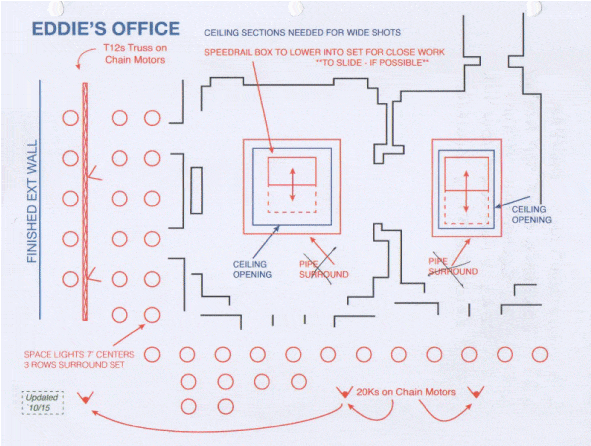

Lighting plan for Eddie’s Office in Hail Caesar!
Deakins and his team placed 20K and T12s on chains so that they could keep the workload down, but adjust the lighting to match the time of day in the script through minor adjustments.
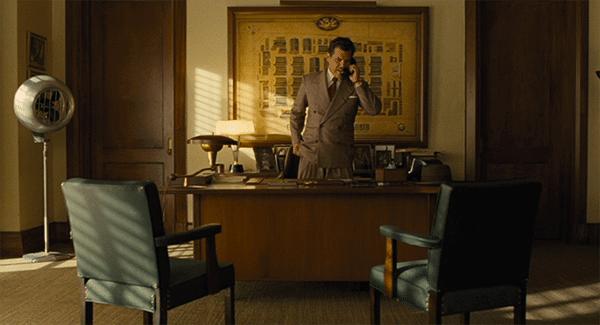

Eddie’s Office in Hail Caesar!
Obviously, it’s nice when you have a standing set and such great gear, but you can emulate these principles on a smaller scale and get images like Roger Deakins.
Hail, Caesar! - The Picture Has Worth Scene
To do this, you want to think about how the situation would be lit if the actual events were taking place at the actual time in the story.
Below is a lighting plan from No Country for Old Men.
If you have a scene that takes place at dawn, light your scene and place your camera so that you get ‘dawn’ like images.
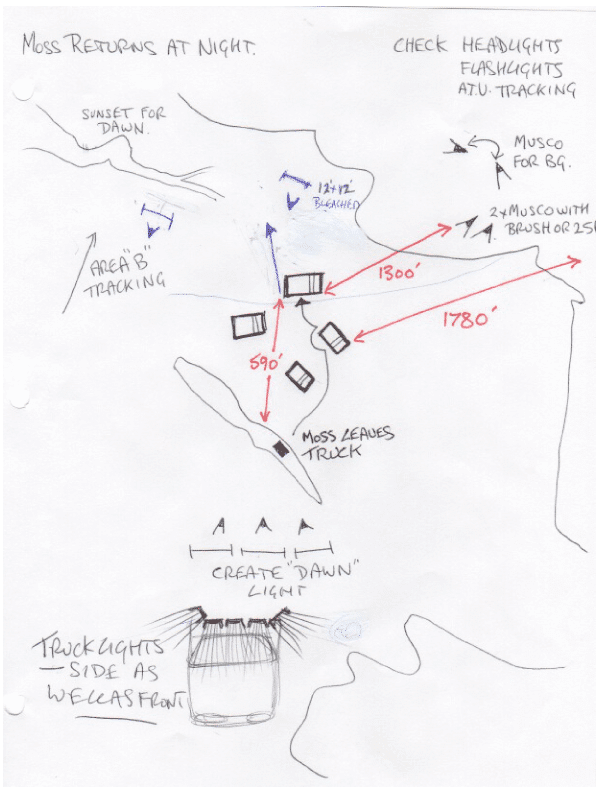

Lighting plan for Basin at Night in No Country for Old Men
Get that silhouette shot because it makes sense.
Don’t just get it because it looks cool or different. Make sure it has logic behind it, or you risk stripping away the willing suspension of disbelief.
The viewer won't question your stylistic choices, but rather be so caught up in the action of your story they aren’t even thinking about the cinematography.
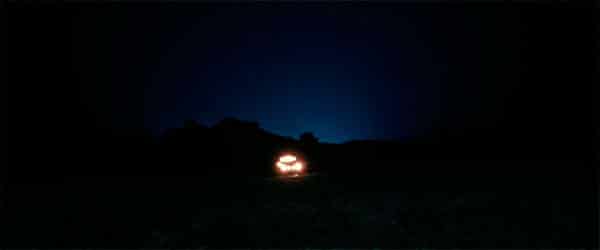

Deakins | No Country for Old Men
This is cool lighting, and very stylized - but why is that? It took a lot of effort to get this image, but the intent was to make it look authentic.
The ‘stylized’ image is really just an accurate representation of what this actual scene would look like if it actually happened.
Deakins | No Country for Old Men
He is confident that the viewer will appreciate authenticity over visual clarity. You can find these materials in more depth on RogerDeakins.com.
Roger deakins oscar movies
Cinematography in Oscar movies
Roger Deakins has been nominated for an Academy Award thirteen times, and he finally won the Oscar for Blade Runner 2049.
Here is a look and analysis of his cinematography in some of those films.
The Shawshank Redemption Cinematography
This is a great scene to break down a bit and see the collaborative choices made by Frank Darabont and Roger Deakins.
Despite the rocky subject matter, Deakins keeps the camera stable.
The filmmakers have the prisoners in frame as much as possible. There are actors at varying depths which give the shot layers.
Notice the quick POV shot as Andy approaches the edge.
Deakins | The Shawshank Redemption
See how the crane gives us a moment of dread, the two prisoners on the ground give us an extra sense of the distance Andy would fall.
The shot supports the speech, and Andy’s knowledge is on display visually. They do a 180 degree line break after Andy convinces the Prison Guard. All of these decisions build a great scene.
Fargo Cinematography
The best thing about Roger Deakins is how he understands the basic fundamentals of visual storytelling, and never leaves value on the table.
Deakins | Fargo
Again, he uses stable footage and this first shot reveals both characters and the entire setting for the scene. He frames Margie’s single over the car so that we can see her face while she detects - humanizing her a bit more than if we were only seeing things from her perspective.
In the wide shots, you can always see everything in the scene framed with perfect composition, and that may have meant moving the cars or moving the camera, but he found a way to get it all in there neatly.
Skyfall Cinematography
Roger Deakins does 007, and that's an interesting mix.
Bond films are all about luxury and the fantasy of being somewhat flawless, whereas Deakins is a much more authentic and ‘dirty’ filmmaker, but he also knows how to adapt his style to the script.
Deakins | Skyfall
There is no doubt he leaned in, and gave us a calm and collected Bond.
I firmly believe the competency level at which we view 007 is connected to the competency of the filmmakers more than the acting or script. This first shot lingers, it's stable, begins up high and cranes down low as the villain introduces himself.
Just because we got to see a new Roger Deakins style doesn’t mean he didn’t bring his favorite tips and techniques with him.
Sicario Cinematography
This scene has lots of eye-lines to worry about, lots of different actions and characters to show the viewer.
Deakins | Sicario
The reason Deakins loves working with Denis Villeneuve is because he uses the medium of cinema to make stories come alive.
Deakins knows that his cinematography will be supported by great sound design that helps tell the story just as much as the shots.
Blade Runner 2049 Cinematography
This is the film he won his first Oscar for, though I personally think he could have won every year and it would have been deserved.
Deakins | Blade Runner 2049
The look and feel of this scene is different from much of the film, but in other cases it matches perfectly. Deakins somehow accomplished making a very colorful film look drab at the same time.
Some of this is the monochromatism, and some the lights and shadows.
Does this scene feel authentic to you?
RELATED POSTS
Up next
How to Make the Perfect Shot List
If Roger Deakins doesn’t inspire you to shoot your next project, I don’t know what will. Check out our post on How to Make a Shot List Using StudioBinder’s Shot List Software where you can sign up for free.
That way you will have precise control over your visuals, and accurately communicate your creative goals so that you get what you need on set.
Next: How to Make a Shot List →
Showcase your vision with elegant shot lists and storyboards.
Create robust and customizable shot lists. Upload images to make storyboards and slideshows.
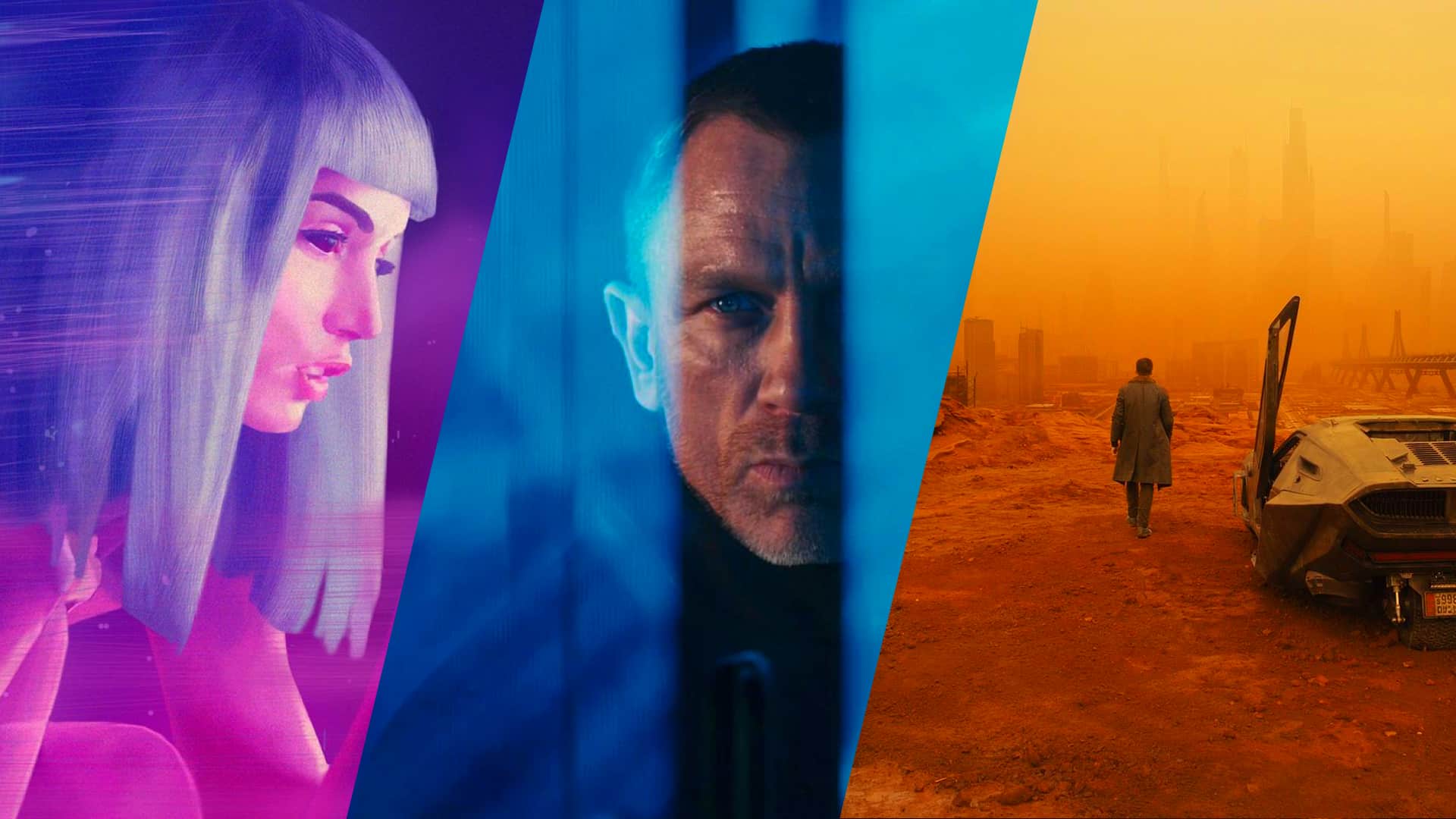
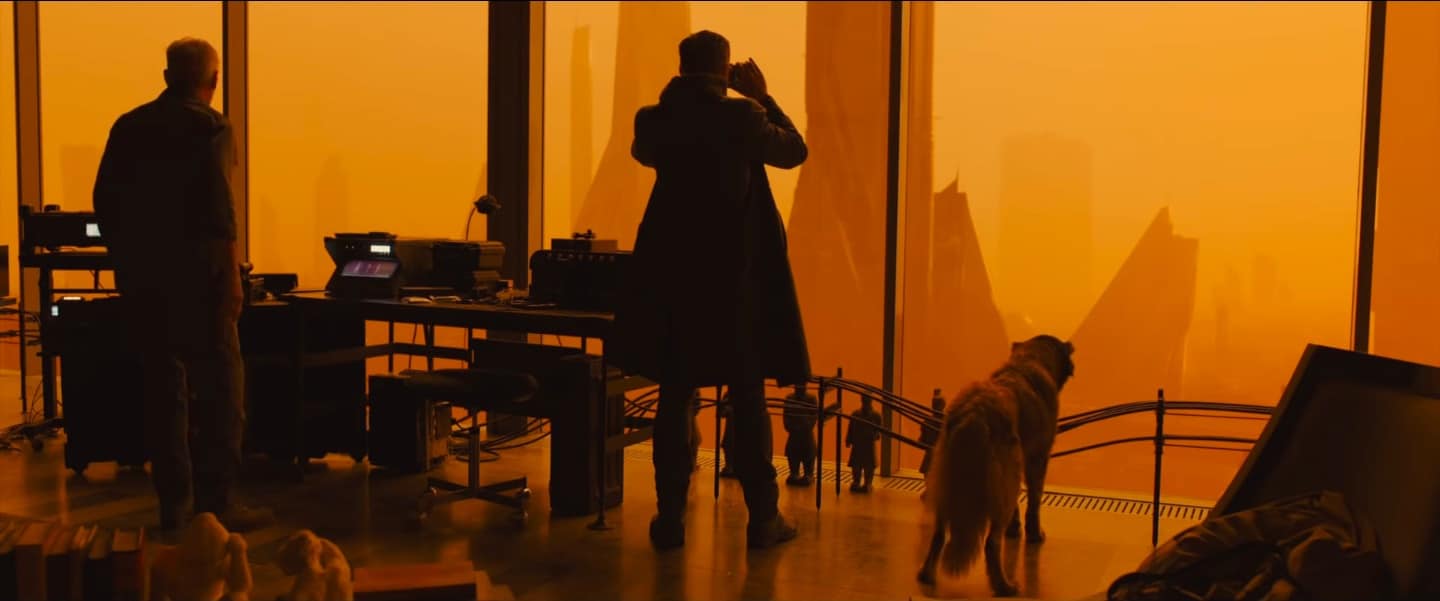
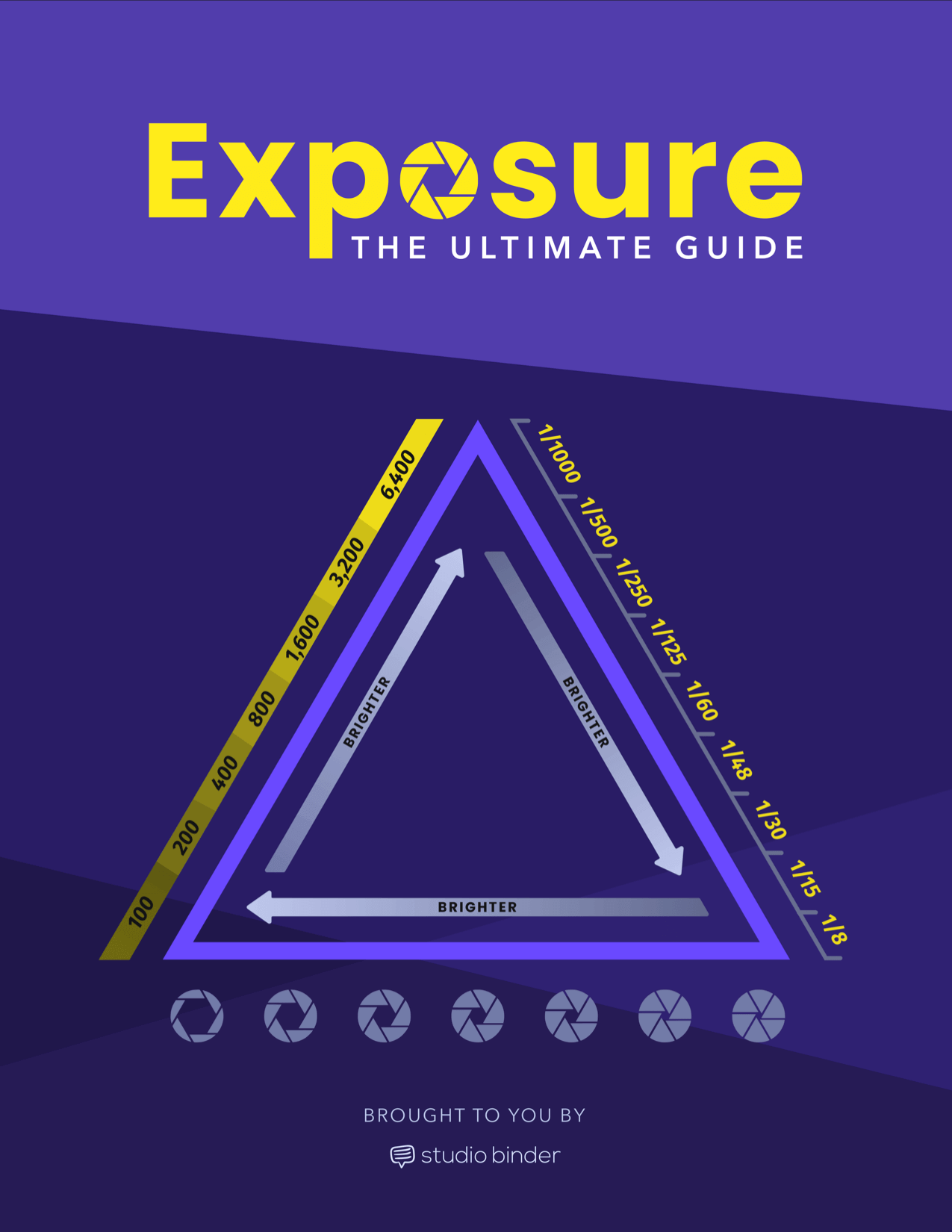
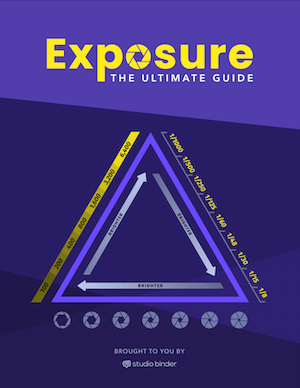
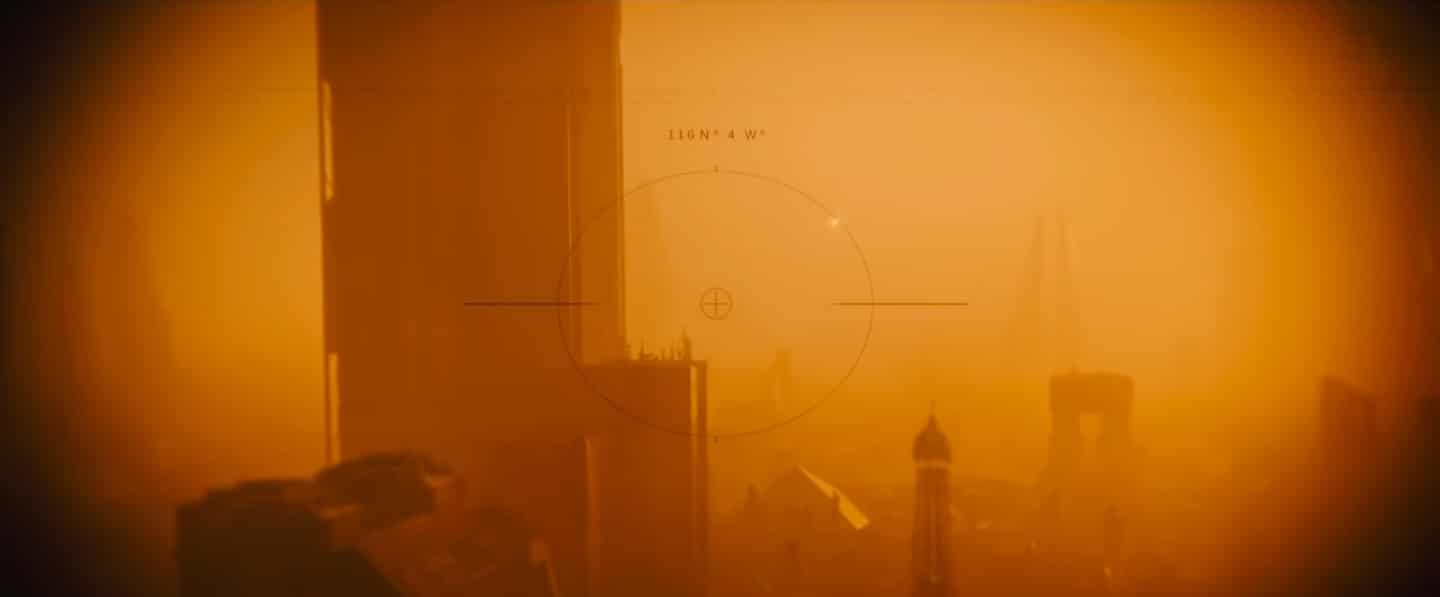
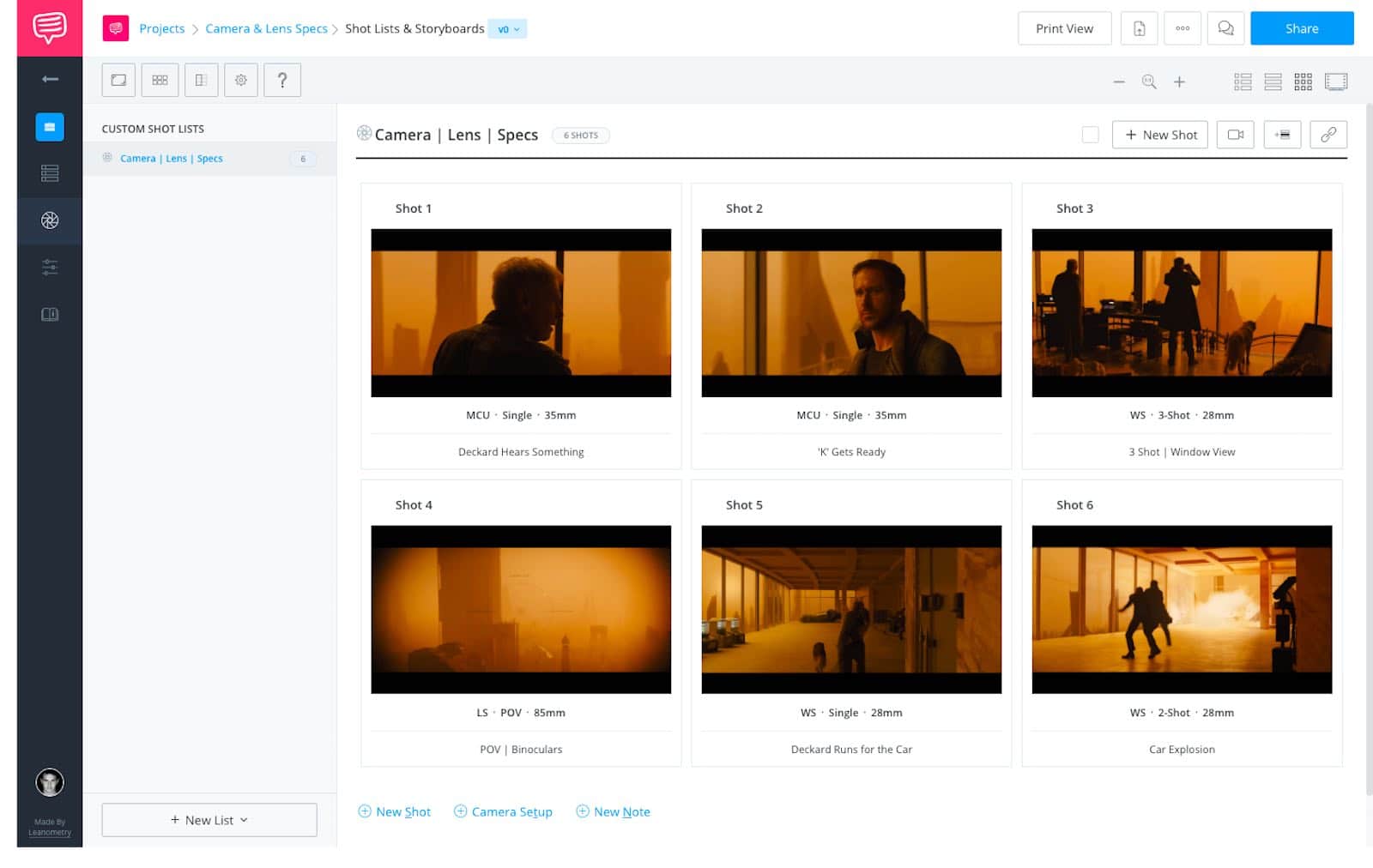
Thanks StudioBinder for spreading so much knowledge about film. It helps so much. Keep doing more and more ????